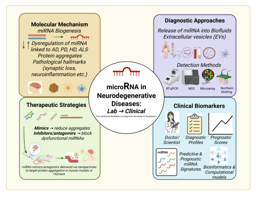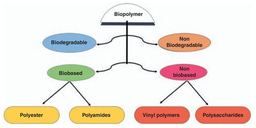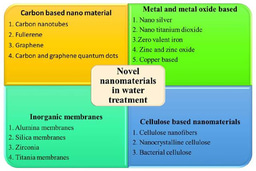MicroRNA Biomarkers as Next-Generation Diagnostic Tools for Neurodegenerative Diseases: A Comprehensive Review
Published in Biomedical Research


Neurodegenerative diseases (NDs), such as Alzheimer’s disease (AD), Parkinson’s disease (PD), Huntington’s disease (HD), Multiple Sclerosis (MS), and Amyotrophic Lateral Sclerosis (ALS), represent a growing global health challenge. These diseases are marked by progressive dysfunction of neurons in the brain and spinal cord, often leading to irreversible cell death. The complexities of their pathophysiology and wide-ranging clinical symptoms make diagnosis and treatment difficult. Early detection is crucial for effective intervention and improving patient outcomes, yet current diagnostic tools often fall short in identifying these conditions before substantial damage has occurred.
Recent advancements have highlighted the potential of microRNAs (miRNAs) as diagnostic biomarkers for early detection of NDs. MiRNAs are small, non-coding RNA molecules that regulate gene expression at the post-transcriptional level. Their ability to control gene networks that influence neuroinflammation, synaptic plasticity, and neuronal survival makes them ideal candidates for detecting neurodegenerative diseases. This review explores the significant role of miRNAs in NDs, their implications for disease progression, and their potential as next-generation diagnostic tools.
The Role of miRNAs in Neurodegenerative Diseases
MiRNAs play a central role in regulating the expression of genes involved in the pathogenesis of various NDs. For example, in Alzheimer’s disease, miRNAs are involved in modulating the synthesis of proteins such as tau and amyloid-beta, which are critical players in disease development. In Parkinson’s disease, miRNAs regulate pathways involved in dopamine production, a neurotransmitter whose depletion underlies the motor symptoms of the disease.
Interestingly, miRNAs do not only regulate individual proteins; they are also involved in broader cellular processes, such as inflammation, oxidative stress, and protein aggregation. These pathways are central to neurodegeneration, and miRNAs provide an opportunity to assess the molecular changes occurring in the brain, even before clinical symptoms become apparent.
Aging and Neurodegenerative Diseases
As the population ages, the prevalence of neurodegenerative diseases is expected to rise dramatically. Aging itself is a major risk factor for the development of NDs, with structural and functional alterations in the brain increasing susceptibility. Aging is associated with progressive neuronal atrophy, particularly in the frontal and temporal lobes, which are critical for cognitive function. The loss of synapses and the accumulation of protein aggregates such as amyloid-beta, tau, and alpha-synuclein are also common features of aging, and these changes often precede the clinical onset of neurodegeneration.
MiRNAs are integral to the aging process and influence the development of age-related diseases, including NDs. The aging brain experiences changes in miRNA expression, which can affect neurogenesis, synaptic plasticity, and protein homeostasis. Understanding how miRNAs are regulated during aging could provide insights into the molecular mechanisms that underlie the development and progression of neurodegenerative diseases.
Post-Translational Modifications (PTMs) and miRNAs
One of the critical ways miRNAs contribute to the regulation of neurodegeneration is through their involvement in post-translational modifications (PTMs). PTMs such as ubiquitination, phosphorylation, and acetylation play essential roles in protein function and stability. For example, miRNAs can target proteins involved in the ubiquitination process, which is crucial for the degradation of misfolded or aggregated proteins—key players in many NDs.
Research has shown that specific miRNAs can regulate proteins involved in the ubiquitin-proteasome system (UPS), a critical pathway for maintaining protein homeostasis. Dysregulation of PTMs, in combination with altered miRNA expression, contributes to the accumulation of toxic protein aggregates that drive neurodegeneration. By targeting miRNAs involved in PTM regulation, we may be able to develop therapeutic strategies aimed at correcting these molecular imbalances and preventing further neuronal damage.
MiRNAs as Biomarkers for Early Detection
One of the most promising aspects of miRNAs is their potential as biomarkers for early detection of NDs. Currently, diagnostic methods for neurodegenerative diseases rely on imaging techniques, such as MRI and PET scans, as well as cerebrospinal fluid (CSF) analysis. However, these methods often detect disease in its later stages, when substantial damage has already occurred. MiRNAs, on the other hand, can be detected in blood, CSF, and other biofluids, offering a non-invasive and cost-effective means of identifying disease in its earliest stages.
Several studies have identified specific miRNAs that are differentially expressed in patients with NDs, suggesting that they could serve as reliable biomarkers for early diagnosis. For example, miRNAs such as miR-34a, miR-146a, and miR-132 have been implicated in Alzheimer’s and Parkinson’s disease, with altered expression patterns correlating with disease severity. The ability to measure these miRNAs in blood or CSF could enable clinicians to detect neurodegeneration before the onset of symptoms, providing a critical window for early intervention.
Challenges and Future Directions
While the potential for miRNAs as biomarkers is substantial, several challenges remain. The variability in miRNA expression, influenced by factors such as age, gender, and disease stage, can complicate the interpretation of results. Additionally, the sensitivity and specificity of miRNA detection methods need further optimization to ensure reliable diagnosis. Advanced technologies such as next-generation sequencing (NGS) and microarray analysis are already helping to address these challenges, but more work is needed to make miRNA-based diagnostics clinically feasible.
Moreover, the regulatory and ethical considerations surrounding miRNA-based diagnostics must be carefully considered. As miRNA profiling becomes more widely adopted in clinical practice, ensuring that these tests meet regulatory standards and are accessible to patients in need will be essential.
Conclusion
MicroRNAs hold significant promise as next-generation biomarkers for neurodegenerative diseases, offering a non-invasive, early diagnostic tool that could change the landscape of disease detection and treatment. By understanding the molecular mechanisms through which miRNAs regulate neurodegeneration, we can develop more targeted therapies aimed at halting or even reversing disease progression. As research continues, miRNAs could not only improve our ability to detect these diseases earlier but also open new avenues for precision medicine, leading to more effective and personalized treatment strategies.
The exploration of miRNAs as biomarkers for neurodegenerative diseases represents a crucial step toward improving diagnostics and treatment options. Collaboration across research fields will be key to unlocking the full potential of miRNAs in the fight against neurodegeneration.
What’s Next?
The journey from lab discovery to clinical application is always challenging, but the potential benefits of miRNA-based diagnostics are too significant to ignore. I invite you to join me in exploring how these tiny molecules could have a big impact on the future of neurodegenerative disease detection and treatment.
What do you think? Do you see miRNA diagnostics playing a key role in the future of early disease detection? What challenges do you think we need to overcome to make this a reality?
Let’s continue the conversation—together, we can push the boundaries of what’s possible.
Link to full article: 10.3389/fnmol.2024.1386735






Please sign in or register for FREE
If you are a registered user on Research Communities by Springer Nature, please sign in
Excited to share this review on the potential of microRNAs (miRNAs) as biomarkers for the early detection of neurodegenerative diseases. We hope our insights help pave the way for more effective diagnostic tools and therapies. Looking forward to your feedback and discussions! https://doi.org/10.3389/fnmol.2024.1386735
Excited to share this review on the potential of microRNAs (miRNAs) as biomarkers for the early detection of neurodegenerative diseases. We hope our insights help pave the way for more effective diagnostic tools and therapies. Looking forward to your feedback and discussions! https://doi.org/10.3389/fnmol.2024.1386735
🧠 Exciting News! Our Review Article is Published!
I’m delighted to share the publication of our new review article in Frontiers in Molecular Neuroscience, titled:
“MicroRNA biomarkers as next-generation diagnostic tools for neurodegenerative diseases: a comprehensive review”
📅 Now online | 🔗 https://doi.org/10.3389/fnmol.2024.1386735
🔍 What makes this review special?
🧬 We explore the crucial role of microRNAs (miRNAs) in the early diagnosis of neurodegenerative diseases such as Alzheimer’s, Parkinson’s, ALS, MS, and HD.
🔬 The review highlights how miRNAs regulate pathways linked to neurodegeneration, especially post-translational modifications, aging, and RNA-binding protein interactions.
🧠 We show how miRNA dysregulation occurs before clinical symptoms, suggesting a powerful tool for pre-symptomatic diagnosis.
👨🔬 This work is a collaboration between experts from BTU Cottbus-Senftenberg, Charité Berlin, DZNE, and University of Potsdam.
📚 If you’re passionate about neuroscience, molecular biology, or early disease detection—this review is a must-read!
📖 Access the full article here:
🔗 https://doi.org/10.3389/fnmol.2024.1386735
🔗 https://go.nature.com/3FSQrke
👇 Drop your thoughts or questions below—I'd love to connect!
📢 Feel free to share with your network!
#MicroRNA #Neurodegeneration #PostTranslationalModifications #AgingAndDisease #MolecularNeuroscience #RNARegulation #GeneExpression #Biomarkers #Alzheimers #Parkinsons #ALS #AmyotrophicLateralSclerosis #MS #MultipleSclerosis #HD #HuntingtonsDisease #EarlyDiagnosis
#FrontiersInNeuroscience #ScientificResearch #BTU #Charite #DZNE #BrainHealth #Epigenetics #NextGenDiagnostics #Neurobiology #miRNABasedDiagnostics
🧠 Exciting News! Our review article is published!
We explore how miRNAs could enhance diagnostics and their role in PTM and Aging 🧠🧬
🔗 https://doi.org/10.3389/fnmol.2024.1386735
🔗 https://go.nature.com/3FSQrke
MicroRNA #Neurodegeneration #PostTranslationalModifications #AgingAndDisease #MolecularNeuroscience #RNARegulation #GeneExpression #Biomarkers #Alzheimers #Parkinsons #ALS #AmyotrophicLateralSclerosis #MS #MultipleSclerosis #HD #HuntingtonsDisease #EarlyDiagnosis#FrontiersInNeuroscience #ScientificResearch #BTU #Charite #DZNE #BrainHealth #Epigenetics #NextGenDiagnostics #Neurobiology #miRNABasedDiagnostics
Reply Follow the Topic Biomedical Research Recommended Content